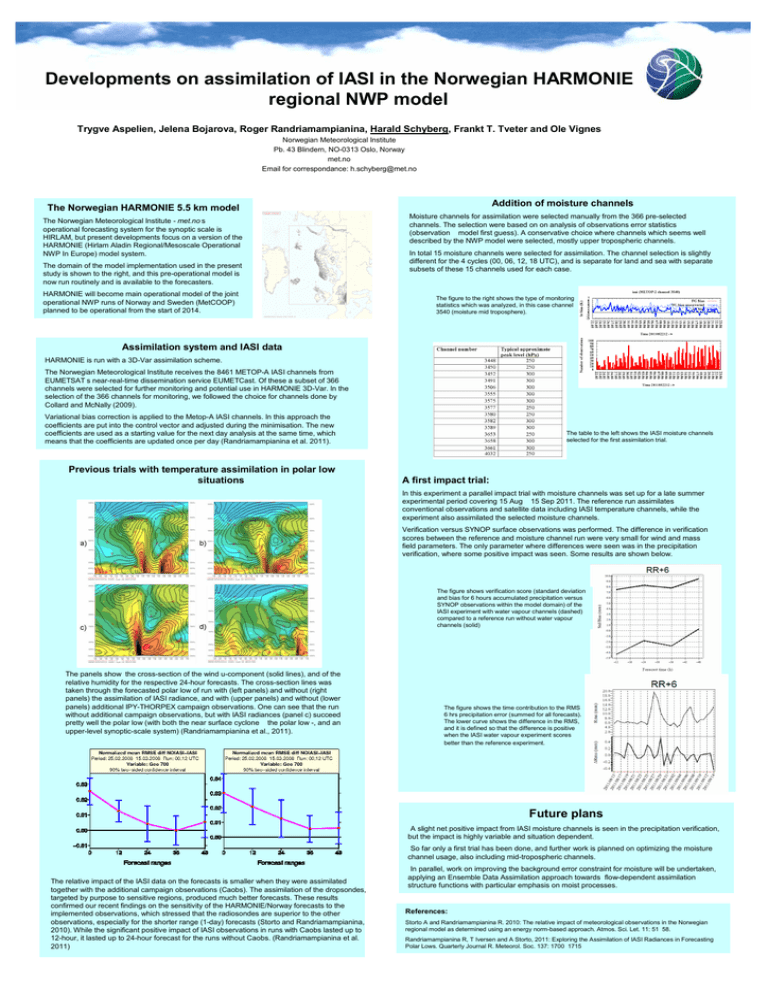Developments on assimilation of IASI in the Norwegian HARMONIE
advertisement

Developments on assimilation of IASI in the Norwegian HARMONIE regional NWP model Trygve Aspelien, Jelena Bojarova, Roger Randriamampianina, Harald Schyberg, Frankt T. Tveter and Ole Vignes Norwegian Meteorological Institute Pb. 43 Blindern, NO-0313 Oslo, Norway met.no Email for correspondance: h.schyberg@met.no Addition of moisture channels The Norwegian HARMONIE 5.5 km model The Norwegian Meteorological Institute - met.no s operational forecasting system for the synoptic scale is HIRLAM, but present developments focus on a version of the HARMONIE (Hirlam Aladin Regional/Mesoscale Operational NWP In Europe) model system. The domain of the model implementation used in the present study is shown to the right, and this pre-operational model is now run routinely and is available to the forecasters. HARMONIE will become main operational model of the joint operational NWP runs of Norway and Sweden (MetCOOP) planned to be operational from the start of 2014. Moisture channels for assimilation were selected manually from the 366 pre-selected channels. The selection were based on on analysis of observations error statistics (observation model first guess). A conservative choice where channels which seems well described by the NWP model were selected, mostly upper tropospheric channels. In total 15 moisture channels were selected for assimilation. The channel selection is slightly different for the 4 cycles (00, 06, 12, 18 UTC), and is separate for land and sea with separate subsets of these 15 channels used for each case. The figure to the right shows the type of monitoring statistics which was analyzed, in this case channel 3540 (moisture mid troposphere). Assimilation system and IASI data HARMONIE is run with a 3D-Var assimilation scheme. The Norwegian Meteorological Institute receives the 8461 METOP-A IASI channels from EUMETSAT s near-real-time dissemination service EUMETCast. Of these a subset of 366 channels were selected for further monitoring and potential use in HARMONIE 3D-Var. In the selection of the 366 channels for monitoring, we followed the choice for channels done by Collard and McNally (2009). Variational bias correction is applied to the Metop-A IASI channels. In this approach the coefficients are put into the control vector and adjusted during the minimisation. The new coefficients are used as a starting value for the next day analysis at the same time, which means that the coefficients are updated once per day (Randriamampianina et al. 2011). Previous trials with temperature assimilation in polar low situations The table to the left shows the IASI moisture channels selected for the first assimilation trial. A first impact trial: In this experiment a parallel impact trial with moisture channels was set up for a late summer experimental period covering 15 Aug 15 Sep 2011. The reference run assimilates conventional observations and satellite data including IASI temperature channels, while the experiment also assimilated the selected moisture channels. Verification versus SYNOP surface observations was performed. The difference in verification scores between the reference and moisture channel run were very small for wind and mass field parameters. The only parameter where differences were seen was in the precipitation verification, where some positive impact was seen. Some results are shown below. The figure shows verification score (standard deviation and bias for 6 hours accumulated precipitation versus SYNOP observations within the model domain) of the IASI experiment with water vapour channels (dashed) compared to a reference run without water vapour channels (solid) The panels show the cross-section of the wind u-component (solid lines), and of the relative humidity for the respective 24-hour forecasts. The cross-section lines was taken through the forecasted polar low of run with (left panels) and without (right panels) the assimilation of IASI radiance, and with (upper panels) and without (lower panels) additional IPY-THORPEX campaign observations. One can see that the run without additional campaign observations, but with IASI radiances (panel c) succeed pretty well the polar low (with both the near surface cyclone the polar low -, and an upper-level synoptic-scale system) (Randriamampianina et al., 2011). The figure shows the time contribution to the RMS 6 hrs precipitation error (summed for all forecasts). The lower curve shows the difference in the RMS, and it is defined so that the difference is positive when the IASI water vapour experiment scores better than the reference experiment. Future plans A slight net positive impact from IASI moisture channels is seen in the precipitation verification, but the impact is highly variable and situation dependent. So far only a first trial has been done, and further work is planned on optimizing the moisture channel usage, also including mid-tropospheric channels. The relative impact of the IASI data on the forecasts is smaller when they were assimilated together with the additional campaign observations (Caobs). The assimilation of the dropsondes, targeted by purpose to sensitive regions, produced much better forecasts. These results confirmed our recent findings on the sensitivity of the HARMONIE/Norway forecasts to the implemented observations, which stressed that the radiosondes are superior to the other observations, especially for the shorter range (1-day) forecasts (Storto and Randriamampianina, 2010). While the significant positive impact of IASI observations in runs with Caobs lasted up to 12-hour, it lasted up to 24-hour forecast for the runs without Caobs. (Randriamampianina et al. 2011) In parallel, work on improving the background error constraint for moisture will be undertaken, applying an Ensemble Data Assimilation approach towards flow-dependent assimilation structure functions with particular emphasis on moist processes. References: Storto A and Randriamampianina R. 2010: The relative impact of meteorological observations in the Norwegian regional model as determined using an energy norm-based approach. Atmos. Sci. Let. 11: 51 58. Randriamampianina R, T Iversen and A Storto, 2011: Exploring the Assimilation of IASI Radiances in Forecasting Polar Lows. Quarterly Journal R. Meteorol. Soc. 137: 1700 1715

